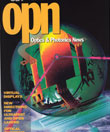
May 1999 Issue
- Can Ultrafast Lasers Meet Industry Expectations?
- The Evolution of Diode-pumped Solid-state Lasers
- Optical Trapping and Manipulation of Neutral Particles Using Lasers
- MEMS Microscanner Raster-scanning Display: A Spyglass for the Future
- Construction Underway at NIF
- Downloading MiKTeX
- Laser Heating of Multilayer Stacks
- Fast Zoom Fisheye Lens for Electronic Cameras
- Fun with Polarizers
- Browse all Issues
Feature Articles
Can Ultrafast Lasers Meet Industry Expectations?
Translating the success of ultrafast lasers as research tools into the commercial marketplace is anything but guaranteed. However, several promising applications are pushing the development of ultrafast lasers as industry tools.
by Susan M. ReissThe Evolution of Diode-pumped Solid-state Lasers
Long lifetimes and high efficiency have made diode-pumped lasers the choice for many applications. Review the basics of how these lasers operate, their applications, and learn about how they can be improved to achieve longer lifetimes and greater power output.
by Andrew LeuzingerOptical Trapping and Manipulation of Neutral Particles Using Lasers
Use of this sensitive and novel technique of trapping and manipulation has revolutionized experimental studies in the fields of light scattering, atomic physics, and the biological sciences. The ability to control the dynamics of small neutral particles enables many fundamental studies and practical applications.
by A. AshkinMEMS Microscanner Raster-scanning Display: A Spyglass for the Future
Micromachined raster scanners promise to enable portable video displays that are lower weight, lower power, and lower cost than presently available video display technologies. The vision of creating an augmented virtual world viewed through an ergonomic, see-through head-mounted display may soon be realized.
by Kam Y. LauConstruction Underway at NIF
Many optics companies are involved in the construction of the National Ignition Facility at Lawrence Livermore National Laboratory. Get a preview of progress on the facility and what to expect in the future.
by John R. MurrayDownloading MiKTeX
While much of the business world seems to be adopting a popular word processing product as a "standard" for document generation, the technical world is less convinced. This stems from the prevalence of symbols and equations in technical documents, the difficulties experienced when trying to enter symbols or equations into a document using the popular word processor, and the low quality of the formatted result. One popular solution to this problem is to use TeX or LaTeX. If the OSA version of the ReVTeX style is used, you obtain the additional advantage that the manuscript can be submitted electronically to OSA journals. Wayne Itano described the installation of a public-domain TeX program, emTeX, several years ago (OPN, October 1991, page 42). Revisions of emTeX have continued to roll out, with a recent version exhibiting a graphical user interface (GUI). Another public-domain TeX/LaTeX package called MiKTeX has a GUI previewer. This month we describe the installation of MiKTeX.
by Bob JopsonLaser Heating of Multilayer Stacks
The physics of laser heating involves the absorption of optical energy and its conversion to heat by the sample, followed by diffusion and redistribution of this thermal energy through the volume of the material. When the sample is inho-mogeneous (as when it consists of several layers of differing optical and thermal properties) the absorption and diffusion processes become quite complex, giving rise to interesting temperature profiles throughout the body of the sample. This article describes some of the phenomena that occur in thin film stacks subjected to localized irradiation. We confine our attention to examples from the field of optical data storage, but the selected examples have many features in common with problems in other areas, and it is hoped that the reader will find this analysis useful in understanding a variety of similar situations.
by Masud MansuripurFast Zoom Fisheye Lens for Electronic Cameras
Fisheye lenses are normally designed to cover a full-field angle of 180°, and are scaled so that the 180° image circle either fits entirely within a rectangular image area (circular fisheye) or just covers the entire diagonal of the image area (diagonal fisheye). This month's design, is an unusual zoom fisheye lens that is a circular fisheye at the short focal length position and a diagonal fisheye at the long focal length position. Unlike most zooms, the field angle remains nearly constant during zooming so that the image circle changes size. Figure 2 shows how the image circle progressively fills the rectangular CCD during zooming. The lens is intended for a 1/3" CCD having a diagonal of 6 mm. The system is telecentric throughout the zoom range to match the characteristics of the detector.
by J. Brian CaldwellFun with Polarizers
Next time you go on the road to do a community outreach program in optics, don't forget to bring polarizers. Coupled with an overhead projector or a light box, they make terrific tools for demonstrating properties of light from birefringence to Rayleigh scattering.
by Michael E. Knotts, Jennifer M. Rice

![A multiplexed image of a human tonsil acquired. [NIAID] using the iterative bleaching extends multiplexity (IBEX) method.](https://opnmedia.blob.core.windows.net/$web/opn/media/images/articles/2024/0424/departments/202404-cover-web.jpg?ext=.jpg)
